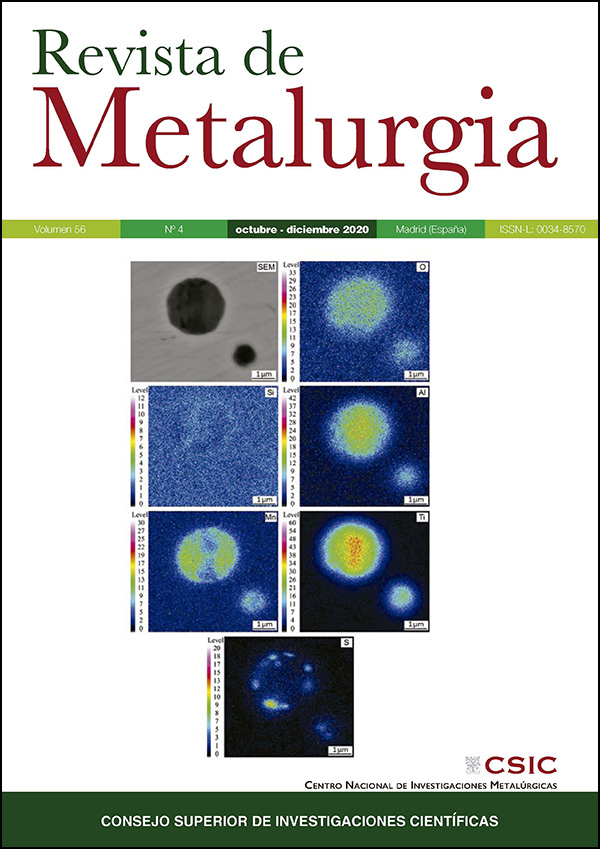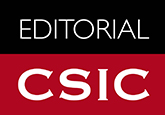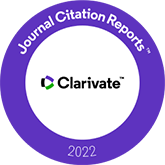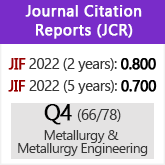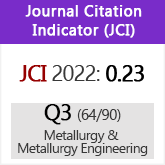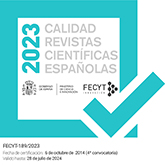Effect of sealing treatment on the corrosion behavior of anodized AA2099 aluminum-lithium alloy
DOI:
https://doi.org/10.3989/revmetalm.180Keywords:
Aluminum-lithium AA2099 alloy, Anodizing, Corrosion, Electrochemical impedance, SEM, XPSAbstract
The corrosion behavior of the sulphuric-anodized AA2099 using two different current densities, 0.19 or 1.0 A·cm−2, with two different sealing treatments in H2O and 6 wt.% Na2Cr2O7 at 95 °C was studied in 3.5 wt.% NaCl and 10 vol.% H2SO4 solutions. The AA2099 is widely used in aeronautical applications, thus it is essential to present good corrosion performance in chloride and acid rain environments. The surface morphology of the anodized film was characterized by scanning electron microscopy (SEM), the electrochemical corrosion behavior was studied using electrochemical impedance (EIS), and finally characterization of the surface chemical composition was revealed by X-ray photoelectron spectroscopy (XPS). It was found the 6 wt.% Na2Cr2O7 sealing treatment imparts a more homogeneous and compact passive layer, and tends to increase the charge transfer resistance, thus improving the corrosion behavior of the anodized AA2099.
Downloads
References
Abrahami, S.T., Hauffman, T., de Kok, J.M.M., Mol, J.M.C, Terryn, H. (2015). XPS Analysis of the surface chemistry and interfacial bonding of barrier-type Cr(VI)-free anodic oxides. J. Phys. Chem. C. 119 (34), 19967-19975. https://doi.org/10.1021/acs.jpcc.5b05958
Ardelean, H., Frateur, I., Zanna, S., Atrens, A., Marcus, P. (2009). Corrosion protection of AZ91 magnesium alloy by anodizing in niobium and zirconium-containing electrolytes. Corros. Sci. 51 (12), 3030-3038. https://doi.org/10.1016/j.corsci.2009.08.030
ASTM G106-89 (2015). Standard practice for verification of algorithm and equipment for electrochemical impedance measurements. ASTM International, West Conshohocken, PA USA.
Ayagou, M.D.D., Tran, T.T.M., Tribollet, B., Kittel, J., Sutter, E., Ferrando, N., Mendibide, C., Duret-Thual, C. (2018). Electrochemical impedance spectroscopy of iron corrosion in H2S solutions. Electrochim. Acta 282, 775-783. https://doi.org/10.1016/j.electacta.2018.06.052
Bastidas, D.M. (2007). Interpretation of impedance data for porous electrodes and diffusion processes. Corrosion 63 (6), 515-521. https://doi.org/10.5006/1.3278402
Bastidas, J.M., Polo, J.L., Torres, C.L., Cano, E. (2001). A study on the stability of AISI 316L stainless steel pitting corrosion through its transfer function. Corros. Sci. 43 (2), 269-281. https://doi.org/10.1016/S0010-938X(00)00082-2
Cumpson, P.J. (1995). Angle-resolved XPS and AES: Depth-resolution limits and a general comparison of properties of depth-profile reconstruction methods. J. Electron Spectrosc. Relat. Phenom. 73 (1), 25-52. https://doi.org/10.1016/0368-2048(94)02270-4
Dale, K.H. (1970). Anodizing aluminum. Patent US3524799A.
Deng, Y., Bai, J., Wu, X., Huang, G., Cao, L., Huang, L. (2017) Investigation on formation mechanism of T1precipitate in an Al-Cu-Li alloy. J. Alloys Compd. 723, 661-666. https://doi.org/10.1016/j.jallcom.2017.06.198
Deschamps, A., Decreus, B., De Geuser, F., Dorin, T., Weyland, M. (2013). The influence of precipitation on plastic deformation of Al-Cu-Li alloys. Acta Mater. 61 (11), 4010-4021. https://doi.org/10.1016/j.actamat.2013.03.015
Deschamps, A., Garcia, M., Chevy, J., Davo, B., De Geuser, F. (2017). Influence of Mg and Li content on the microstructure evolution of Al-Cu-Li alloys during long-term ageing. Acta Mater. 122, 32-46. https://doi.org/10.1016/j.actamat.2016.09.036
Djellab, M., Bentrah, H., Chala, A., Taoui, H. (2019). Synergistic effect of halide ions and gum arabic for the corrosion inhibition of API5L X70 pipeline steel in H2SO4. Mater. Corros. 70 (1), 149-160. https://doi.org/10.1002/maco.201810203
Etienne, M., Rocca, E., Chahboun, N., Veys-Renaux, D. (2016). Local evolution of pH with time determined by shear force-based scanning electrochemical microscopy: Surface reactivity of anodized aluminium. Electroanalysis 28 (10), 2466-2471. https://doi.org/10.1002/elan.201600294
Evertsson, J., Bertram, F., Rullik, L., Harlow, G., Lundgren, E. (2017). Anodization of Al(100), Al(111) and Al Alloy 6063 studiedin situwith X-ray reflectivity and electrochemical impedance spectroscopy. J. Electroanal. Chem. 799, 556-562. https://doi.org/10.1016/j.jelechem.2017.07.010
Fajardo, S.,Llorente, I.,Jiménez, J.A.,Bastidas, J.M.,Bastidas, D.M. (2019). Effect of Mn additions on the corrosion behaviour of TWIP Fe-Mn-Al-Si austenitic steel in chloride solution. Corros. Sci. 154, 246-253. https://doi.org/10.1016/j.corsci.2019.04.026
Gumbmann, E., De Geuser, F., Deschamps, A., Lefebvre, W., Robaut, F., Sigli, C. (2016a). A combinatorial approach for studying the effect of Mg concentration on precipitation in an Al-Cu-Li alloy. Scripta. Mater. 110, 44-47. https://doi.org/10.1016/j.scriptamat.2015.07.042
Gumbmann, E., Lefebvre, W., De Geuser, F., Sigli, C., Deschamps, A. (2016b). The effect of minor solute additions on the precipitation path of an Al-Cu-Li alloy. Acta Mater. 115, 104-114. https://doi.org/10.1016/j.actamat.2016.05.050
Halvorsen, I.J., Pivac, I., Bezmalinović, D., Barbir, F., Zenith, F. (2019). Electrochemical low-frequency impedance spectroscopy algorithm for diagnostics of PEM fuel cell degradation. Int. J. Hydrog. Energy 45 (2), 1325-1334.. https://doi.org/10.1016/j.ijhydene.2019.04.004
Hirschorn, B., Orazem, M.E., Tribollet, B., Vivier, V., Frateur, I., Musiani, M. (2010). Determination of effective capacitance and film thickness from constant-phase-element parameters. Electrochim. Acta 55 (21), 6218-6227. https://doi.org/10.1016/j.electacta.2009.10.065
Jaimes-Ramírez, R., Covelo, A., Rodil, S.E., Corona-Lira, P., Ramírez-Reivich, A.C., Hernández, M. (2018). Development and characterization of hydrophobic anodized aluminum layer to act as a long-lasting protective film in corrosion. Surf. Interface Anal. 50 (11), 1030-1035. https://doi.org/10.1002/sia.6437
Jinlong, L., Tongxiang, L., Chen, W., Ting, G. (2016). The passive film characteristics of several plastic deformation 2099 Al-Li alloy. J. Alloys Compd. 662, 143-149. https://doi.org/10.1016/j.jallcom.2015.12.051
Jirón-Lazos, U., Corvo, F., De la Rosa, S.C., García-Ochoa, E.M., Bastidas, D.M., Bastidas, J.M. (2018). Localized corrosion of aluminum alloy 6061 in the presence ofAspergillus niger. Int. Biodeter. Boidegr. 133, 17-25. https://doi.org/10.1016/j.ibiod.2018.05.007
Keller, F., Hunter, M.S., Robinson, D.L. (1953). Structural features of oxide coatings on aluminum. J. Electrochem. Soc. 100, 411-419. https://doi.org/10.1149/1.2781142
Khan, M.F., Kumar, A.M., Ul-Hamid, A., Al-Hems, L.M. (2019). Achieving non-adsorptive anodized film on Al-2024 alloy: Surface and electrochemical corrosion investigation. Surf. Interfaces 15, 78-88. https://doi.org/10.1016/j.surfin.2019.02.005
Klotz, D. (2019). Negative capacitance or inductive loop? - A general assessment of a common low frequency impedance feature. Electrochem. Commun. 98, 58-62. https://doi.org/10.1016/j.elecom.2018.11.017
Liou, Y.-J., Chen, Y.J., Chen, B.-R., Lee, L.-M., Huang, C.-H. (2013). XPS study of aluminum coating on TiO2 anode of dye-sensitized solar cells. Surf. Coat. Tech. 231, 535-538. https://doi.org/10.1016/j.surfcoat.2012.02.008
Ma, Y., Zhou, X., Thompson, G.E., Curioni, M., Zhong, X., Koroleva, E., Skeldon, P., Thomson, P., Fowles, M. (2011). Discontinuities in the porous anodic film formed on AA2099-T8 aluminium alloy. Corros. Sci. 53 (12), 4141-4151. https://doi.org/10.1016/j.corsci.2011.08.023
Ma, Y., Chen, X., Zhou, X., Yi, Y., Liao, Y., Huang, W. (2015a). Microstructural origin of localized corrosion in anodized AA2099-T8 aluminium-lithium alloy. Surf. Interface Anal. 48 (8), 739-744. https://doi.org/10.1002/sia.5856
Ma, Y., Zhou, X., Huang, W., Liao, Y., Chen, X., Zhang, X., Thompson, G.E. (2015b). Crystallographic defects induced localised corrosion in AA2099-T8 aluminium alloy. Corros. Eng. Sci. Technol. 50 (6), 420-424. https://doi.org/10.1179/1743278214Y.0000000237
Ma, Y.-L., Zhou, X.-R., Meng, X.-M., Huang, W.-J., Liao, Y., Chen, X.-L., Yi, Y.-N., Zhang, X.-X., Thompson, G.E. (2016). Influence of thermomechanical treatments on localized corrosion susceptibility and propagation mechanism of AA2099 Al-Li alloy. T. Nonferr. Metal. Soc. China 26 (6), 1472-1481. https://doi.org/10.1016/S1003-6326(16)64252-8
Mouritz, A.P. (2012). Introduction to Aerospace Materials. Woodhead Publishing, PA, USA. https://doi.org/10.1533/9780857095152
Pérez, N. (2004). Electrochemistry and Corrosion Science. Springer, NY, USA. https://doi.org/10.1007/b118420
Pérez, O.E.L., Sánchez, M.D., Teijelo, M.L. (2010). Characterization of growth of anodic antimony oxide films by ellipsometry and XPS. J. Electroanal. Chem. 645 (2), 143-148. https://doi.org/10.1016/j.jelechem.2010.04.023
Pivac, I., Barbir, F. (2016). Inductive phenomena at low frequencies in impedance spectra of proton exchange membrane fuel cells - A review. J. Power Sources 326, 112-119. https://doi.org/10.1016/j.jpowsour.2016.06.119
Romios, M., Tiraschi, R., Ogren, J.R., Es-Said, O.S., Parrish, C., Babel, H.W. (2005). Design of multistep aging treatments of 2099 (C458) Al-Li alloy. J. Mater. Eng. Perform. 14, 641-646. https://doi.org/10.1361/105994905X64594
Runge, J.M. (2018). The Metallurgy of Anodizing Aluminum. Springer, Chicago, USA. https://doi.org/10.1007/978-3-319-72177-4
Ryu, S.-K., Park, B.-J., Park, S.-J. (1999). XPS Analysis of Carbon Fiber Surfaces-Anodized and Interfacial Effects in Fiber-Epoxy Composites. J. Colloid Interface Sci. 215 (1), 167-169. https://doi.org/10.1006/jcis.1999.6240 PMid:10362485
Scully, J.R., Silverman, D.C., Kendig, M.W. (1993). Electrochemical impedance: Analysis and interpretation. STP 1188. ASTM International, USA. https://doi.org/10.1520/STP1188-EB
Skeldon, P., Wang, H.W., Thompson G.E. (1997). Formation and characterization of self-lubricating MoS2precursor films on anodized aluminium. Wear 206 (1-2), 187-196. https://doi.org/10.1016/S0043-1648(96)07350-4
Tian, Y., Robson, J.D., Riekehr, S., Kashaev, N., Wang, L., Lowe, T., Karanika, A. (2016). Process optimization of dual-laser beam welding of advanced Al-Li alloys through hot cracking susceptibility modeling. Metall. Mater. Trans. A 47, 3533-3544. https://doi.org/10.1007/s11661-016-3509-4
Yang, Y., Cheng, J., Liu, S., Wang, H., Dong, P. (2019). Effect of NaAlO2 sealing on corrosion resistance of 2024 aluminum alloy anodized film. Mater. Corros. 70 (1), 120-127. https://doi.org/10.1002/maco.201810327
Yu, S., Wang, L., Wu, C., Feng, T., Cheng, Y., Bu, Z., Zhu, S. (2020). Studies on the corrosion performance of an effective and novel sealing anodic oxide coating. J. Alloys Compd. 817, 153257. https://doi.org/10.1016/j.jallcom.2019.153257
Zhang, F., Örnek, C., Nilsson, J.O., Pan, J. (2020). Anodisation of aluminium alloy AA7075-Influence of intermetallic particles on anodic oxide growth. Corros. Sci. 164, 108319. https://doi.org/10.1016/j.corsci.2019.108319
Zuo, Y., Zhao, P.H., Zhao, J.M. (2003). The influences of sealing methods on corrosion behavior of anodized aluminum alloys in NaCl solutions. Surf. Coat. Technol. 166, 237-242. https://doi.org/10.1016/S0257-8972(02)00779-X
Published
How to Cite
Issue
Section
License
Copyright (c) 2020 Consejo Superior de Investigaciones Científicas (CSIC)

This work is licensed under a Creative Commons Attribution 4.0 International License.
© CSIC. Manuscripts published in both the printed and online versions of this Journal are the property of Consejo Superior de Investigaciones Científicas, and quoting this source is a requirement for any partial or full reproduction.All contents of this electronic edition, except where otherwise noted, are distributed under a “Creative Commons Attribution 4.0 International” (CC BY 4.0) License. You may read here the basic information and the legal text of the license. The indication of the CC BY 4.0 License must be expressly stated in this way when necessary.
Self-archiving in repositories, personal webpages or similar, of any version other than the published by the Editor, is not allowed.
Funding data
Consejo Nacional de Ciencia y Tecnología
Grant numbers CB 253272;A1-S-8882
University of Akron
Grant numbers 639430
